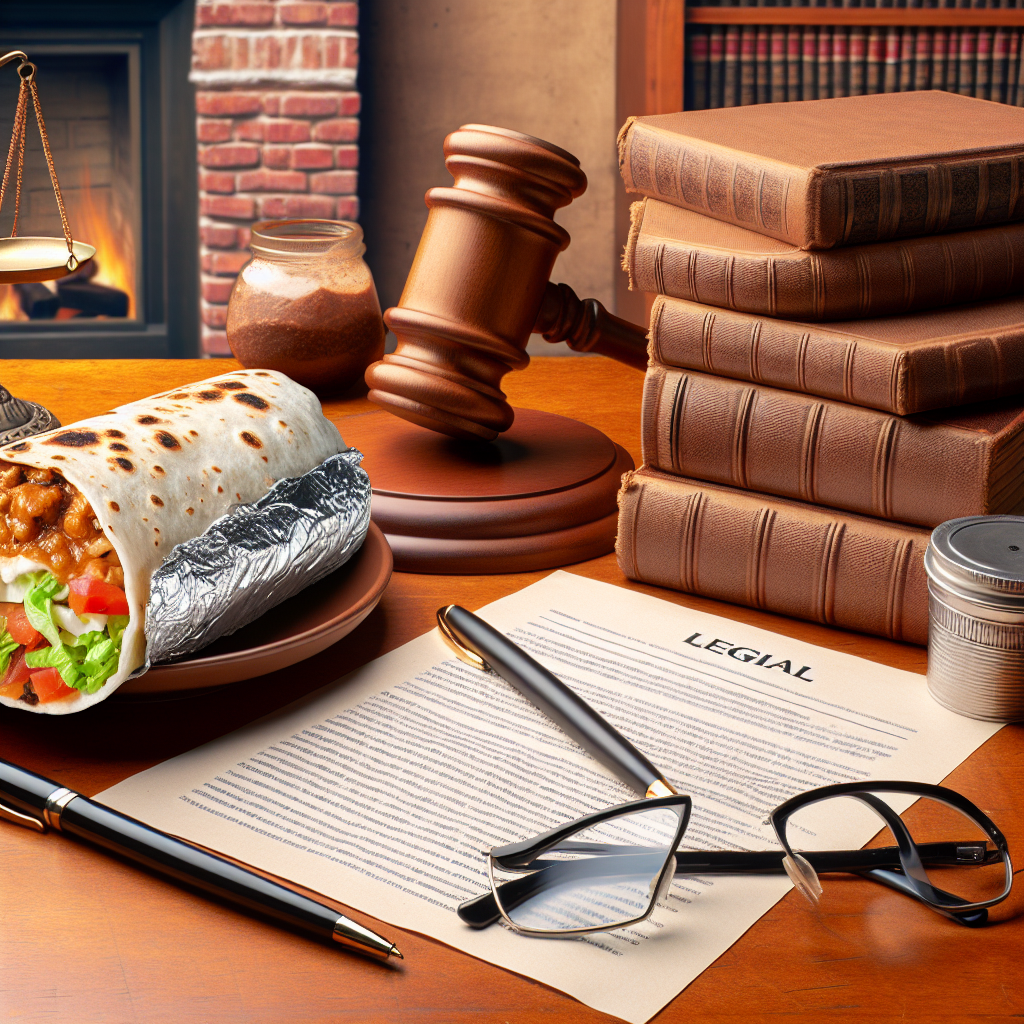“Chipotle’s Serving Size Scandal: When Portions Don’t Measure Up!”
Introduction
In recent developments, Chipotle Mexican Grill has found itself embroiled in a legal battle following a viral controversy over portion sizes. The lawsuit, filed by disgruntled customers, alleges that the popular fast-casual restaurant chain has been misleading consumers with its advertised portion sizes, which reportedly fall short of expectations. This legal action comes in the wake of widespread social media attention, where numerous patrons have shared their dissatisfaction and experiences with what they perceive as inconsistent and inadequate servings. As the case unfolds, it raises significant questions about advertising practices and consumer rights in the fast-food industry.
Legal Implications Of Portion Size Disputes In The Fast Food Industry
In recent years, the fast food industry has been no stranger to legal disputes, particularly those concerning portion sizes. A notable example is the recent lawsuit faced by Chipotle, a popular fast-casual restaurant chain, over allegations of misleading portion sizes. This controversy, which gained significant attention on social media platforms, highlights the broader legal implications of portion size disputes within the fast food sector. As consumers become increasingly vigilant about the value they receive for their money, the scrutiny over portion sizes has intensified, leading to potential legal challenges for companies like Chipotle.
The lawsuit against Chipotle centers around claims that the restaurant chain has been serving portions that are significantly smaller than advertised. This discrepancy was brought to light through viral videos and posts on social media, where customers shared their experiences of receiving less food than expected. Such public exposure has not only damaged Chipotle’s reputation but also raised questions about the legal responsibilities of fast food companies in accurately representing their offerings. In this context, the legal implications are multifaceted, involving consumer protection laws, advertising standards, and contractual obligations.
Consumer protection laws play a crucial role in regulating the fast food industry, ensuring that companies provide accurate information about their products. When portion sizes fall short of what is advertised, it can be argued that consumers are being misled, which may constitute a violation of these laws. In the case of Chipotle, the lawsuit alleges that the company engaged in deceptive practices by advertising larger portion sizes than what was actually served. If proven, such actions could result in significant legal penalties and necessitate changes in how the company markets its products.
Moreover, advertising standards are another critical aspect of this legal landscape. Fast food companies are required to adhere to specific guidelines when promoting their products, ensuring that advertisements are truthful and not misleading. The Chipotle lawsuit underscores the importance of these standards, as discrepancies between advertised and actual portion sizes can lead to accusations of false advertising. This not only exposes companies to legal action but also erodes consumer trust, which can have long-term repercussions for brand loyalty and market share.
In addition to consumer protection and advertising issues, portion size disputes also touch upon contractual obligations between businesses and their customers. When a customer purchases a meal, there is an implicit contract that they will receive the product as described. If the portion size is smaller than promised, it could be argued that the company has breached this contract. Legal proceedings in such cases often focus on whether the company failed to deliver on its promises and what remedies are available to affected consumers.
As the Chipotle lawsuit unfolds, it serves as a cautionary tale for the fast food industry at large. Companies must be vigilant in ensuring that their marketing practices align with the actual products they deliver. This involves not only adhering to legal standards but also maintaining transparency and honesty in their communications with consumers. By doing so, fast food chains can mitigate the risk of legal disputes and preserve their reputation in an increasingly competitive market. Ultimately, the Chipotle controversy highlights the need for greater accountability and integrity in the fast food industry, as consumers continue to demand fair value for their purchases.
Consumer Expectations Vs. Reality: The Chipotle Portion Size Debate
In recent months, Chipotle Mexican Grill has found itself at the center of a legal battle that has captured the attention of consumers and industry analysts alike. The lawsuit, which stems from a viral controversy over portion sizes, raises important questions about consumer expectations and the realities of fast-casual dining. As the case unfolds, it highlights the delicate balance that restaurants must maintain between marketing promises and actual customer experiences.
The controversy began when a series of social media posts went viral, showcasing Chipotle meals that appeared to be significantly smaller than advertised. Customers shared images of their orders, comparing them to promotional materials that depicted more generous portions. These posts quickly gained traction, sparking widespread debate about whether Chipotle was delivering on its promise of hearty, satisfying meals. The ensuing public outcry prompted a group of disgruntled customers to file a lawsuit, alleging that the company engaged in deceptive marketing practices.
At the heart of the lawsuit is the claim that Chipotle’s advertising misleads consumers by depicting portion sizes that are not consistently delivered in practice. The plaintiffs argue that this discrepancy constitutes false advertising, as it creates an expectation that is not met when customers receive their orders. In response, Chipotle has maintained that portion sizes can vary due to a range of factors, including ingredient availability and the discretion of individual employees. The company asserts that it strives to provide a consistent experience but acknowledges that some variation is inevitable in a fast-paced, made-to-order environment.
This legal dispute underscores a broader issue faced by many in the food service industry: the challenge of managing consumer expectations. In an era where social media can amplify individual experiences to a global audience, restaurants are under increased scrutiny to deliver on their promises. The Chipotle case serves as a reminder that even minor discrepancies between marketing and reality can have significant repercussions, both legally and reputationally.
Moreover, the lawsuit raises questions about the role of consumer perception in shaping brand loyalty. For many customers, the perceived value of a meal is closely tied to portion size, which can influence their overall satisfaction and likelihood of returning. As such, companies must carefully consider how their marketing materials align with the actual dining experience they provide. Failure to do so can lead to a disconnect that erodes trust and damages a brand’s reputation.
In navigating these challenges, transparency and communication are key. By clearly articulating what customers can expect and addressing any discrepancies promptly, companies can mitigate potential backlash and foster a more positive relationship with their clientele. Additionally, soliciting feedback and making adjustments based on customer input can demonstrate a commitment to meeting consumer needs and expectations.
As the Chipotle lawsuit progresses, it will undoubtedly serve as a case study for the industry, offering valuable insights into the complexities of managing consumer expectations in a digital age. While the outcome remains uncertain, the controversy has already sparked important conversations about the responsibilities of food service providers and the power of consumer voices. Ultimately, this case highlights the need for a careful balance between marketing aspirations and operational realities, a challenge that will continue to shape the landscape of the fast-casual dining sector.
The Role Of Social Media In Amplifying Brand Controversies
In recent years, social media has emerged as a powerful tool for consumers to voice their opinions and grievances, often leading to significant repercussions for brands. The latest example of this phenomenon is the lawsuit faced by Chipotle, a popular fast-casual restaurant chain, over a viral controversy regarding portion sizes. This incident underscores the critical role social media plays in amplifying brand controversies, transforming individual complaints into widespread public discourse.
The controversy began when a customer posted a video on a popular social media platform, showcasing what they claimed to be a significantly smaller portion size than what was advertised. The video quickly gained traction, amassing millions of views and sparking a heated debate among users. Many individuals shared similar experiences, while others defended the brand, suggesting that portion sizes can vary based on location and staff discretion. Nevertheless, the video set off a chain reaction, with numerous users tagging Chipotle’s official social media accounts, demanding explanations and accountability.
As the video continued to circulate, it caught the attention of mainstream media outlets, further amplifying the issue. News articles and television segments began to explore the broader implications of the controversy, questioning whether Chipotle’s portion sizes were consistently meeting customer expectations. This media coverage not only heightened public awareness but also put additional pressure on the company to address the situation promptly and transparently.
In response to the growing backlash, Chipotle issued a statement on its social media channels, acknowledging the concerns raised by customers and promising to investigate the matter thoroughly. The company emphasized its commitment to providing value and quality to its patrons, while also highlighting the challenges of maintaining uniform portion sizes across its numerous locations. Despite these efforts, the damage had already been done, as the viral nature of the controversy had already shaped public perception.
The lawsuit that followed further exemplifies the power of social media in transforming consumer dissatisfaction into legal action. The plaintiffs, emboldened by the widespread support and visibility garnered through social media, argued that Chipotle’s advertising was misleading and that the company had failed to deliver on its promises. This legal battle not only poses financial risks for Chipotle but also threatens to tarnish its reputation, potentially impacting customer loyalty and future sales.
This incident serves as a cautionary tale for brands operating in the digital age, highlighting the need for proactive engagement with consumers on social media platforms. Companies must recognize that social media is not merely a marketing tool but a dynamic space where customer experiences and opinions are shared and scrutinized. By actively monitoring and addressing concerns in real-time, brands can mitigate the risk of controversies escalating to the point of legal action.
Moreover, this case illustrates the importance of transparency and consistency in brand messaging. In an era where information spreads rapidly, discrepancies between advertised promises and actual experiences can quickly become focal points for public criticism. Brands must ensure that their marketing materials accurately reflect the products and services they offer, thereby minimizing the potential for consumer dissatisfaction and subsequent backlash.
In conclusion, the Chipotle portion size controversy underscores the influential role of social media in amplifying brand controversies. As consumers continue to leverage these platforms to hold companies accountable, brands must adapt by prioritizing transparency, consistency, and proactive engagement. By doing so, they can navigate the challenges of the digital landscape and maintain positive relationships with their customers.
How Chipotle’s Lawsuit Could Impact Its Brand Reputation

Chipotle Mexican Grill, a prominent player in the fast-casual dining sector, is currently embroiled in a legal battle that could have significant implications for its brand reputation. The lawsuit, which has garnered widespread attention, centers around allegations of misleading portion sizes, a controversy that has gone viral on social media platforms. As the case unfolds, it is crucial to examine how this legal challenge might affect Chipotle’s standing in the eyes of consumers and investors alike.
To begin with, the lawsuit alleges that Chipotle has been serving portions that are significantly smaller than advertised, leading to accusations of deceptive marketing practices. This controversy gained traction when customers began sharing their experiences online, often accompanied by images comparing their meals to the promotional materials. The viral nature of these posts has amplified the issue, drawing the attention of both the public and regulatory bodies. Consequently, Chipotle now faces the dual challenge of addressing the legal claims while also managing the court of public opinion.
In the realm of brand reputation, transparency and trust are paramount. Chipotle has long been celebrated for its commitment to using fresh, high-quality ingredients and for its transparency regarding sourcing and preparation methods. However, the current allegations threaten to undermine this carefully cultivated image. If consumers begin to perceive a disconnect between Chipotle’s marketing promises and the reality of their dining experience, the brand could suffer a loss of trust that may be difficult to rebuild.
Moreover, the impact of this lawsuit extends beyond consumer perception. Investors are also closely monitoring the situation, as any significant damage to Chipotle’s brand reputation could have financial repercussions. A decline in customer trust and satisfaction could lead to decreased sales, which in turn might affect the company’s stock performance. Additionally, the legal costs associated with defending against the lawsuit, as well as any potential settlements or fines, could further strain Chipotle’s financial resources.
In response to the controversy, Chipotle has taken steps to address the concerns raised by customers and to mitigate potential damage to its reputation. The company has issued statements emphasizing its commitment to customer satisfaction and has promised to review its portion sizes and marketing practices. By taking proactive measures, Chipotle aims to demonstrate its dedication to transparency and to reassure both consumers and investors of its integrity.
Nevertheless, the outcome of the lawsuit remains uncertain, and its resolution will likely play a critical role in shaping Chipotle’s future brand image. If the company is found liable for misleading practices, it may face not only financial penalties but also long-term reputational damage. On the other hand, a favorable outcome could help Chipotle reinforce its commitment to honesty and quality, potentially restoring consumer confidence.
In conclusion, the lawsuit over portion sizes presents a significant challenge for Chipotle, with potential ramifications for its brand reputation. As the company navigates this legal and public relations crisis, it must balance the need to address consumer concerns with the imperative to protect its financial interests. Ultimately, the manner in which Chipotle handles this controversy will be instrumental in determining its ability to maintain its standing as a trusted and respected brand in the competitive fast-casual dining industry.
The Economics Of Portion Sizes: Balancing Cost And Customer Satisfaction
In recent years, the fast-casual dining industry has witnessed a growing debate over portion sizes, with Chipotle Mexican Grill finding itself at the center of a legal controversy. The lawsuit, which has garnered significant media attention, revolves around allegations that the popular restaurant chain has been misleading customers with its portion sizes. This case highlights the delicate balance that food service providers must maintain between cost management and customer satisfaction, a challenge that is becoming increasingly complex in today’s economic climate.
The controversy began when a viral video surfaced, showing a Chipotle employee serving what appeared to be a smaller-than-expected portion of food. This incident sparked widespread discussion on social media platforms, with many customers expressing dissatisfaction over perceived inconsistencies in portion sizes. As the video gained traction, it caught the attention of legal experts, leading to a class-action lawsuit against Chipotle. The plaintiffs argue that the company has engaged in deceptive practices by advertising larger portions than what is actually served, thus violating consumer protection laws.
From an economic perspective, portion sizes are a critical component of a restaurant’s business model. They directly impact food costs, pricing strategies, and ultimately, profitability. For a company like Chipotle, which prides itself on using high-quality, fresh ingredients, maintaining a balance between generous portions and cost efficiency is essential. However, as food prices continue to rise due to inflation and supply chain disruptions, restaurants face increasing pressure to adjust portion sizes to protect their bottom line. This economic reality often clashes with customer expectations, as diners seek value for their money, especially in a competitive market where alternatives are readily available.
Moreover, the psychology of portion sizes plays a significant role in customer satisfaction. Research has shown that consumers often equate larger portions with better value, even if the actual nutritional content or quality of the food remains unchanged. This perception can influence dining choices and brand loyalty, making it imperative for restaurants to carefully consider how portion sizes are perceived by their clientele. In Chipotle’s case, the viral video and subsequent lawsuit have brought this issue to the forefront, forcing the company to reevaluate its portion size policies and communication strategies.
In response to the lawsuit, Chipotle has maintained that its portion sizes are consistent with industry standards and that any discrepancies are isolated incidents rather than systemic issues. The company has also emphasized its commitment to transparency and customer satisfaction, pledging to review its training procedures and ensure that employees adhere to portion guidelines. This proactive approach aims to rebuild trust with customers and mitigate potential damage to the brand’s reputation.
As the legal proceedings unfold, the outcome of this case could have broader implications for the fast-casual dining industry. It serves as a reminder of the importance of clear communication and consistency in meeting customer expectations. Furthermore, it underscores the need for restaurants to adapt to changing economic conditions while maintaining a focus on delivering value to their patrons.
In conclusion, the Chipotle portion size controversy highlights the intricate relationship between economics and customer satisfaction in the food service industry. As companies navigate the challenges of rising costs and evolving consumer preferences, finding the right balance will be crucial to sustaining success in an increasingly competitive market. The resolution of this lawsuit may offer valuable insights into how restaurants can effectively manage portion sizes to meet both financial objectives and customer demands.
Lessons For Fast Food Chains From Chipotle’s Legal Battle
In recent months, Chipotle Mexican Grill has found itself embroiled in a legal battle that has captured the attention of both consumers and industry experts alike. The lawsuit, which centers around allegations of misleading portion sizes, has sparked a broader conversation about transparency and customer expectations in the fast food industry. As the case unfolds, it offers valuable lessons for fast food chains striving to maintain consumer trust and uphold their brand integrity.
The controversy began when a viral video surfaced, purportedly showing Chipotle employees serving portions significantly smaller than advertised. This video quickly gained traction on social media, leading to widespread consumer dissatisfaction and, ultimately, a class-action lawsuit. The plaintiffs argue that Chipotle’s marketing practices are deceptive, as the portions served do not match the images and descriptions presented in advertisements. This situation underscores the importance of aligning marketing materials with actual product offerings, a lesson that extends beyond Chipotle to the entire fast food sector.
One of the primary takeaways from this legal battle is the critical role of transparency in maintaining consumer trust. In an era where information is readily accessible and shared at lightning speed, customers are more informed and discerning than ever before. They expect honesty and consistency from the brands they patronize. Fast food chains, therefore, must ensure that their marketing practices accurately reflect the products they serve. This includes not only portion sizes but also ingredient quality and nutritional information. By doing so, they can build and sustain a loyal customer base that feels confident in their purchasing decisions.
Moreover, the Chipotle lawsuit highlights the potential repercussions of failing to meet customer expectations. In the fast food industry, where competition is fierce and margins are often slim, negative publicity can have a significant impact on a brand’s reputation and bottom line. The rapid spread of information via social media means that any perceived misstep can quickly escalate into a public relations crisis. Fast food chains must be proactive in addressing customer concerns and rectifying any discrepancies between their marketing and actual offerings. This may involve revisiting portion guidelines, enhancing employee training, or even reevaluating marketing strategies to ensure they are both truthful and compelling.
Another lesson to be gleaned from Chipotle’s predicament is the importance of effective communication with consumers. When faced with allegations or complaints, fast food chains should prioritize open and honest dialogue with their customers. This involves not only addressing the specific issue at hand but also demonstrating a commitment to continuous improvement. By engaging with consumers and showing a willingness to listen and adapt, brands can mitigate the damage caused by negative publicity and reinforce their dedication to customer satisfaction.
In conclusion, the lawsuit against Chipotle serves as a cautionary tale for fast food chains navigating the complex landscape of consumer expectations and brand integrity. By prioritizing transparency, meeting customer expectations, and maintaining open lines of communication, fast food brands can safeguard their reputation and foster long-term loyalty. As the industry continues to evolve, these lessons will remain crucial for any chain seeking to thrive in an increasingly competitive market. Ultimately, the Chipotle case underscores the enduring importance of trust and authenticity in the fast food sector, reminding brands that their success hinges on the satisfaction and confidence of their customers.
The Future Of Transparency In Fast Food Marketing Practices
In recent years, the fast food industry has been under increasing scrutiny for its marketing practices, particularly concerning transparency and consumer expectations. A recent lawsuit against Chipotle has brought these issues to the forefront, highlighting the challenges that fast food chains face in maintaining consumer trust. The lawsuit, which centers around allegations of misleading portion sizes, has sparked a broader conversation about the future of transparency in fast food marketing practices.
The controversy began when a viral video surfaced, showing a Chipotle employee preparing a burrito bowl with what appeared to be significantly smaller portions than advertised. This video quickly gained traction on social media, leading to widespread consumer outrage and accusations of deceptive marketing practices. In response, Chipotle has faced a class-action lawsuit, with plaintiffs arguing that the company has consistently misrepresented the size of its portions, thereby misleading customers and violating consumer protection laws.
This legal battle underscores the growing demand for transparency in the fast food industry. As consumers become more health-conscious and informed, they are increasingly scrutinizing the claims made by fast food companies. This shift in consumer behavior has placed pressure on these companies to provide accurate and honest information about their products. In the case of Chipotle, the lawsuit has raised questions about the accuracy of its marketing materials and whether the company has been forthright in its advertising.
Moreover, this controversy has broader implications for the fast food industry as a whole. It serves as a reminder that transparency is not just a legal obligation but also a crucial component of building and maintaining consumer trust. As such, fast food companies must be proactive in ensuring that their marketing practices align with consumer expectations. This includes providing clear and accurate information about portion sizes, nutritional content, and ingredient sourcing.
In light of these developments, many industry experts are calling for increased regulation and oversight of fast food marketing practices. They argue that stricter guidelines are necessary to ensure that companies are held accountable for their claims and that consumers are protected from misleading information. This could involve more rigorous standards for advertising and labeling, as well as greater transparency in the supply chain.
Furthermore, the Chipotle lawsuit highlights the role of social media in shaping consumer perceptions and holding companies accountable. In today’s digital age, consumers have a powerful platform to voice their concerns and share their experiences. This has created a new dynamic in which companies must be more responsive and transparent in their interactions with customers. Failure to do so can result in significant reputational damage and legal consequences.
In conclusion, the lawsuit against Chipotle over portion size discrepancies is a pivotal moment for the fast food industry. It underscores the importance of transparency in marketing practices and the need for companies to be honest and forthcoming with their customers. As the industry continues to evolve, it is imperative that fast food chains prioritize transparency and accountability to build trust and maintain their competitive edge. This case serves as a cautionary tale for other companies, highlighting the potential risks of failing to meet consumer expectations in an increasingly transparent world.
Q&A
1. **What is the lawsuit against Chipotle about?**
The lawsuit alleges that Chipotle misled customers with advertisements showing larger portion sizes than what was actually served.
2. **Who filed the lawsuit against Chipotle?**
The lawsuit was filed by a group of customers who felt deceived by the portion sizes depicted in Chipotle’s promotional materials.
3. **What triggered the viral controversy regarding Chipotle’s portion sizes?**
The controversy began when images and videos comparing advertised portion sizes to actual servings went viral on social media, sparking widespread consumer dissatisfaction.
4. **How has Chipotle responded to the lawsuit?**
Chipotle has stated that they believe the claims are unfounded and that they are committed to transparency and customer satisfaction.
5. **What are the customers seeking in the lawsuit against Chipotle?**
The plaintiffs are seeking compensation for damages, claiming they were misled into purchasing meals that did not meet advertised expectations.
6. **Has Chipotle faced similar lawsuits in the past?**
Yes, Chipotle has faced previous lawsuits related to food safety and advertising practices, though the outcomes have varied.
7. **What impact has the lawsuit had on Chipotle’s business?**
The lawsuit has generated negative publicity, potentially affecting customer trust and sales, though the long-term impact remains uncertain.
Conclusion
The lawsuit against Chipotle over the viral portion size controversy highlights the growing consumer demand for transparency and accountability in the food industry. As customers increasingly rely on social media to voice their dissatisfaction, companies must ensure that their marketing practices align with actual product offerings to maintain trust and brand integrity. This case underscores the importance of clear communication and consistency in fulfilling customer expectations, which are crucial for sustaining consumer loyalty and avoiding legal challenges.





